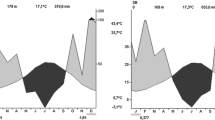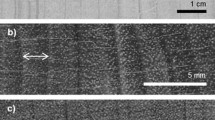Abstract
Understanding of the extent to which reproductive costs drive growth largely derives from reproductively mature temperate trees in masting and non-masting years. We modeled basal area increment (BAI) and explored current growth–reproduction tradeoffs and changes in such allocation over the life span of a long-lived, non-masting tropical tree. We integrated rainfall and soil variables with data from 190 Bertholletia excelsa trees of different diameter at breast height (DBH) sizes, crown characteristics, and liana loads, quantifying BAI and reproductive output over 4 and 6 years, respectively. While rainfall explains BAI in all models, regardless of DBH class or ontogenic stage, light (based on canopy position and crown form) is most critical in the juvenile (5 cm ≤ DBH < 50 cm) phase. Suppressed trees are only present as juveniles and grow ten times slower (1.45 ± 2.73 m2 year−1) than trees in dominant and co-dominant positions (13.25 ± 0.82 and 12.90 ± 1.35 m2 year−1, respectively). Additionally, few juvenile trees are reproductive, and those that are, demonstrate reduced growth, as do reproductive trees in the next 50 to 100 cm DBH class, suggesting growth–reproduction tradeoffs. Upon reaching the canopy, however, and attaining a sizeable girth, this pattern gradually shifts to one where BAI and reproduction are influenced independently by variables such as liana load, crown size and soil properties. At this stage, BAI is largely unaffected by fruit production levels. Thus, while growth–reproduction tradeoffs clearly exist during early life stages, effects of reproductive allocation diminish as B. excelsa increases in size and maturity.




Similar content being viewed by others
References
Akaike H (1973) Information theory as an extension of the maximum likelihood principle. In: Pretrov BN, Csaki FF (eds) Proceedings of the Second International Symposium on Information Theory. Akademiai Kiado, Budapest, pp 267–281
Brienen RJW, Zuidema PA (2005) Relating tree growth to rainfall in Bolivian rain forests: a test for six species using tree ring analysis. Oecologia 146:1–2
Brienen RJW, Zuidema PA (2006) Lifetime growth patterns and ages of Bolivian rain forest trees obtained by tree ring analysis. J Ecol 94:481–493
Burnham KP, Anderson DR (2002) Model selection and multi-model inference: a practical information-theoretic approach, 2nd edn. Springer, New York
Camargo PB, Salomão RP, Trumbore S, Martinelli LA (1994) How old are large Brazil-nut trees (Bertholletia excelsa) in the Amazon? Scientia Agricola 51:389–391
Chazdon RL, Pearcy RW, Lee DW, Fetcher N (1996) Photosynthetic responses of tropical forest plants to contrasting light environments. In: Mulkey SS, Chazdon RL, Smith AP (eds) Tropical forest plant ecophysiology. Chapman and Hall, New York, pp 5–55
Clark DA, Clark DB (1992) Life-history diversity of canopy and emergent trees in a neotropical rain-forest. Ecol Monogr 62:315–344
Clark DB, Clark DA (1996) Abundance, growth and mortality of very large trees in neotropical lowland rain forest. For Ecol Manage 80:235–244
Denslow JS, Schultz JC, Vitousek PM, Strain BR (1990) Growth-responses of tropical shrubs to treefall gap environments. Ecology 71:165–179
Diniz TD de AS, Bastos TX (1974) Contribuição ao conhecimento do clima típico da castanha do Brasil. Boletim Técnico. Instituto de Pesquisas e Experimentação Agropecuárias do Norte 64:59–7
EMBRAPA—Empresa Brasileira de Pesquisa Agropecuária (1997) Manual de métodos de análise de solos, 2ª edn. Centro Nacional de Pesquisa em Solos, Rio de Janeiro
FUNTAC—Fundação de Tecnologia do Estado do Acre (2008) Atlas do estado do Acre. FUNTAC, Rio Branco
Gama JRNF, Kushaba T, Ota T, Amano Y (1992) Influência de material vulcânico em alguns solos do estado do Acre. Rev Bras Ciência do Solo 16:103–106
Harper JL, White J (1974) The demography of plants. Ann Rev Ecol Syst 5:419–463
Herrera C, Jordano P, Guitian J, Ttaveset A (1998) Annual variability in seed production by wood plants and the masting concept: reassessment of principles and relationship to pollination and seed dispersal. Am Nat 152:576–594
IMAC—Instituto de Meio Ambiente do Acre (1991) Atlas geográfico ambiental do Acre. IMAC, Rio Branco
Janzen DH (1974) Tropical blackwater rivers, animals, and mast fruiting by the Dipterocarpaceae. Biotropica 7:347–391
Janzen DH (1976) Why bamboos wait so long to flower. Annu Rev Ecol Syst 7:347–391
Kainer KA, Wadt LHO, Gomes-Silva DAP, Capanu M (2006) Liana loads and their association with Bertholletia excelsa fruit and nut production, diameter growth and crown attributes. J Trop Ecol 22:147–154
Kainer KA, Wadt LHO, Staudhammer CL (2007) Explaining variation in Brazil nut fruit production. For Ecol Manage 250:244–255
Kelly D (1994) The evolutionary ecology of mast seeding. Trends Ecol Evol 9:465–470
Kelly D, Sork VL (2002) Mast seeding in perennial plants: why, how, where? Ann Rev Ecol Syst 33:427–447
King DA, Davies SJ, Supardi MNN, Tan S (2005) Tree growth is related to light interception and wood density in two mixed dipterocarp forests of Malaysia. Funct Ecol 19:445–453
Knops JMH, Koenig WD, Carmen WJ (2007) Negative correlation does not imply a tradeoff between growth and reproduction in California oaks. Proc Natl Acad Sci USA 104:16982–16985
Koenig WD, Knops JMH (2000) Patterns of annual seed production by northern hemisphere trees: a global perspective. Am Nat 155(1):59–69
Koenig WD, Mumme RL, Carmen WJ, Stanback MT (1994) Acorn production by oaks in central coastal California: variation within an among years. Ecology 75:99–109
Littell RC, Milliken GA, Stroup WW, Wolfinger RD, Schabenberger O (2006) SAS for mixed models, 2nd edn. SAS Institute Inc., Cary
Maués MM (2002) Reproductive phenology and pollination of the Brazil nut tree (Bertholletia excelsa Humb. & Bonpl. Lecythidaceae) in Eastern Amazonia. In: Kevan P, Imperatriz Fonseca VL (eds) Pollinating bees: the conservation link between agriculture and nature. Ministry of the Environment, Brasilia, Brazil, pp 245–254
Monks A, Kelly D (2006) Testing the resource-matching hypothesis in the mast seeding tree Nothofagus truncate (Fagaceae). Austral Ecol 31:366–375
Newberry DM, Chuyong GB, Zimmermann L (2006) Mast fruiting of large ectomycorrhizal African rain forest trees: importance of dry season intensity, and the resource-limitation hypothesis. New Phytol 170:561–579
O’Malley DM, Buckley DP, Prance GT, Bawa KS (1988) Genetics of Brazil nut (Bertholletia excelsa Humb. & Bonpl.: lecythidaceae). Theor Appl Genet 76:929–932
Obeso JR (2002) The costs of reproduction in plants. New Phytol 155:321–348
Oliver CD, Larson BC (1996) Forest stand dynamics, update edition. Wiley, New York
Pélissier R, Pascal J-P (2000) Two-year tree growth patterns investigated from monthly girth records using dendrometer bands in a wet evergreen forest in India. J Trop Ecol 16:429–446
Poorter L, Kitajima K (2007) Carbohydrate storage and light requirements of tropical moist and dry forest tree species. Ecology 88:1000–1011
Prance GT (1990) Bertholletia. In: Mori SA, Prance GT (eds) Lecythidaceae-Part II: the zygomorphic-flowered New World genera. Flora Neotropica Monograph 21. New York Botanical Garden, Bronx, New York, pp 114–118
Rüger N, Berger U, Hubbell SP, Vieilledent G, Condit R (2011a) Growth strategies of tropical tree species: disentangling light and size effects. PLoS ONE 6:1–10
Rüger N, Huth A, Hubbell SP, Condit R (2011b) Determinants of mortality across a tropical lowland rainforest community. Oikos 120:1047–1056
Sánchez-Humanes B, Sork VL (2011) Trade-offs between vegetative growth and acorn production in Quercus lobata during a mast year: the relevance of crop size and hierarchical level within the canopy. Oecologia 166:101–110
Schabenberger O, Pierce FJ (2001) Contemporary statistical models for the plant and soil sciences. CRC Press, Boca Raton
Schnitzer SA, Bongers F (2002) The ecology of lianas and their role in forests. Trends Ecol Evol 17:223–230
Sutherland S (1986) Patterns of fruit-set: what controls fruit-flower ratios in plants? Evolution 40:117–128
Synnott TJ (1979) A manual of permanent sample plot procedures for tropical rainforests. Tropical Forestry Papers No. 14. Commonwealth Forestry Institute, University of Oxford, Oxford
Thomas SC (2011) Age-related changes in tree growth and functional biology: the role if reproduction. In: Meinzer FC, Lachenbruch B, Dawson TE (eds) Size- and age-related changes in tree structure and function. 1st edn. Tree Physiol 4, Springer, New York, pp 33–64
Tonini H (2011) Fenologia da castanheira-do-brasil (Bertholletia excelsa Humb. & Bonpl., Lecythidaceae) no Sul do Estado de Roraima. Cerne 17:123–131
Souza C Jr, Veríssimo, A, Silva Costa A de, Salomão Reis R, Balieiro C, Ribeiro J (2006) Dinâmica do desmatamento no estado do Acre (1988-2004). IMAZON (Instituto do Homen e Meio Ambiento da Amazônia), Belém, Pará, Brazil
Vieira S, de Camargo PB, Selhorst D, da Silva R, Hutyra L, Chambers JQ, Brown IF, Higuchi N, dos Santos J, Wofsy SC, Trumbore SE, Martinelli LA (2004) Forest structure and carbono dynamics in Amazonian tropical rain forests. Oecologia 140:468–479
Vieira S, Trumbore S, Camargo PB, Selhorst D, Chambers JQ, Higuchi N (2005) Slow growth rates of Amazonian trees: consequences for carbon cycling. Proc Natl Acad Sci USA 102:18502–18507
Wadt LHO, Kainer KA, Gomes-Silva DAP (2005) Population structure and nut yield of a Bertholletia excelsa stand in Southwestern Amazonia. For Ecol Manage 211:371–384
Wright SJ, Muller-Landau HC, Calderon O, Hernandéz A (2005) Annual and spatial variation in seedfall and seedling recruitment in a neotropical forest. Ecology 86:848–860
Yasumura Y, Hikosaka K, Hirose T (2006) Resource allocation to vegetative and reproductive growth in relation to mast seeding in Fagus crenata. For Ecol Manage 229:228–233
Zoneamento Ecológico-Econômico do Acre (ZEE) (2000) Recursos naturais e meio ambiente. Volume I. Secretaria de Estado de Ciência, Tecnologia e Meio Ambiente, Rio Branco, Acre, Brazil
Zuidema PA (2003) Ecology and management of the Brazil nut tree (Bertholletia excelsa). PROMAB (Programa Manejo de Bosques de la Amazonia Boliviana), Ribertalta, Bolivia
Zuidema PA, Boot RGA (2002) Demography of the Brazil nut tree (Bertholletia excelsa) in the Bolivian Amazon: impact of seed extraction on recruitment and population dynamics. J Trop Ecol 18:1–31
Acknowledgments
This research was supported by grants from Embrapa (Kamukaia Project), FINEP/MCT/CNPq (Castanhac Project), MCT/CNPq (Proc. 480016/2008-9 Universal) in Brazil, The William and Flora Hewlett Foundation in the US, and the International Science Foundation, Sweden through a grant to Dr Wadt. We also thank the Embrapa technicians and research interns for their superior field assistance. Finally, we are most grateful to Valderi and Maria Alzenira who graciously shared their forest home.
Author information
Authors and Affiliations
Corresponding author
Additional information
Communicated by Ram Oren.
Rights and permissions
About this article
Cite this article
Staudhammer, C.L., Wadt, L.H.O. & Kainer, K.A. Tradeoffs in basal area growth and reproduction shift over the lifetime of a long-lived tropical species. Oecologia 173, 45–57 (2013). https://doi.org/10.1007/s00442-013-2603-1
Received:
Accepted:
Published:
Issue Date:
DOI: https://doi.org/10.1007/s00442-013-2603-1




